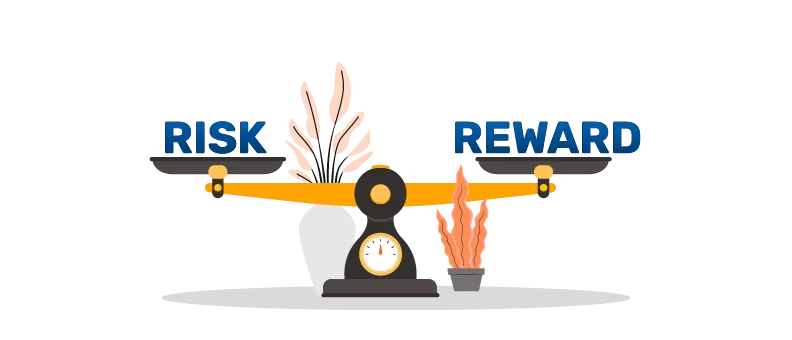Using a compounding calculator to plan your investments


Working towards a financial goal – especially one that has a long horizon – can be challenging. It may be hard to estimate what your initial capital needs to be or to assess the pay-off potential of years of disciplined investing.
A compounding calculator can help you plan your investments by determining the potential returns over a specified time horizon and the expected rate of return. This can help investors understand how different investment choices impact their wealth over time.
In this article, we'll discuss how investors can use compounding calculators to make informed decisions.
Table of contents:
- What is a compounding calculator
- Analysing risk and reward using a compounding calculator
- Balancing risk and reward
- Benefits of using a compounding calculator
- FAQs
What is a compounding calculator
The compounding effect on your investments is what enables them to potentially build wealth over time. Compounding happens when the interest or returns are reinvested into a scheme.
A compounding calculator can help investors visualize the growth of their investments over time. The calculator determines the future value of an investment by factoring in the initial principal, the potential rate of return, and the time horizon. Investors can see how their money can grow exponentially over time as both the initial investment and the returns earn additional returns.
Analysing risk and reward using a compounding calculator
Investments are subject to market risks, so there is no foolproof way to determine your returns. A compounding calculator, however, can help you assess potential returns for different market scenarios.
Risks associated with investments include market volatility, economic factors, and individual security risks. Inputting various values for the expected rate of return across market cycles (bullish, bearish, sideways, etc.) can help investors project their future returns based on the economic climate.
Balancing risk and reward
The balance of risk and reward is critical for achieving satisfactory investment outcomes. Funds with a higher return potential also entail higher risk. So, when choosing a mutual fund, investors should consider their risk tolerance, investment goals, and time horizon.
By adjusting these variables, investors can strike a balance between achieving growth potential and managing risk. For example, younger investors with a longer time horizon may be more willing to take on higher levels of risk in pursuit of greater returns, while retirees may prioritize capital preservation and lower volatility.
Benefits of using a compounding calculator
Visualise long-term growth
A compounding calculator enables investors to see how their investments can grow over time through the power of compounding. By adjusting variables such as investment amount and rate of return, investors can explore various scenarios and make informed decisions.
Evaluate investment strategies
Investors can use a compounding calculator to compare investment strategies and assess their potential outcomes. By analysing scenarios with varying asset allocations and time horizons, investors can identify the optimal strategy that balances risk and reward based on their financial goals.
Make informed decisions
By understanding the potential growth of their investments through compounding, investors can make more informed decisions about asset allocation, risk tolerance, and investment choices. A compounding calculator empowers investors to align their investment decisions with their long-term financial objectives.
Conclusion Using a compounding calculator can help investors to gain insights into the growth potential of their investments over time. However, it's essential to understand the risks and rewards associated with investing and to balance these factors effectively. By deploying a compounding calculator, investors can clearly visualise how changing market situations and varying return rates can impact their investment over the long term, and make portfolio adjustments accordingly.
FAQs
How to use the power of a compounding calculator?
A. To use the power of a compounding calculator, input the initial investment amount, the expected rate of return, and the time horizon. The calculator will then compute the future value of the investment, taking into account the compounding effect. Adjusting these variables allows investors to explore different scenarios and make informed decisions.
How to achieve a balanced investment using a compounding calculator?
Achieving a balanced investment using a compounding calculator involves considering various factors like risk tolerance, investment goals, and time horizon. By inputting different scenarios with varying rates of return and timeframes, investors can assess the potential growth of their investments. Striving for a balance between growth potential and risk management is essential. Diversification across asset classes can further enhance balance and mitigate risk.
What is the accuracy of a compounding calculator?
The accuracy of a compounding calculator depends on the inputs provided and the assumptions made. When using historical data or projected rates of return, there's always a degree of uncertainty. Furthermore, compounding calculators may not account for factors like taxes, fees, or market volatility, which can affect actual investment returns.
Mutual Fund investments are subject to market risks, read all scheme related documents carefully.
This document should not be treated as endorsement of the views/opinions or as investment advice. This document should not be construed as a research report or a recommendation to buy or sell any security. This document is for information purpose only and should not be construed as a promise on minimum returns or safeguard of capital. This document alone is not sufficient and should not be used for the development or implementation of an investment strategy. The recipient should note and understand that the information provided above may not contain all the material aspects relevant for making an investment decision. Investors are advised to consult their own investment advisor before making any investment decision in light of their risk appetite, investment goals and horizon. This information is subject to change without any prior notice.